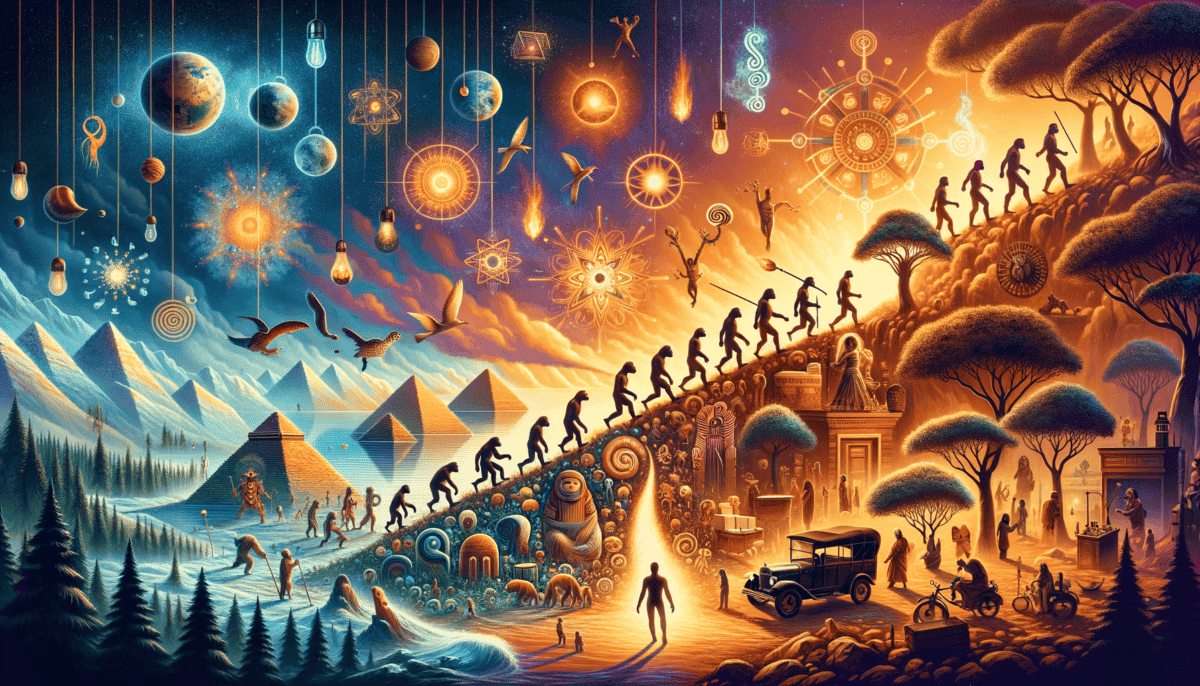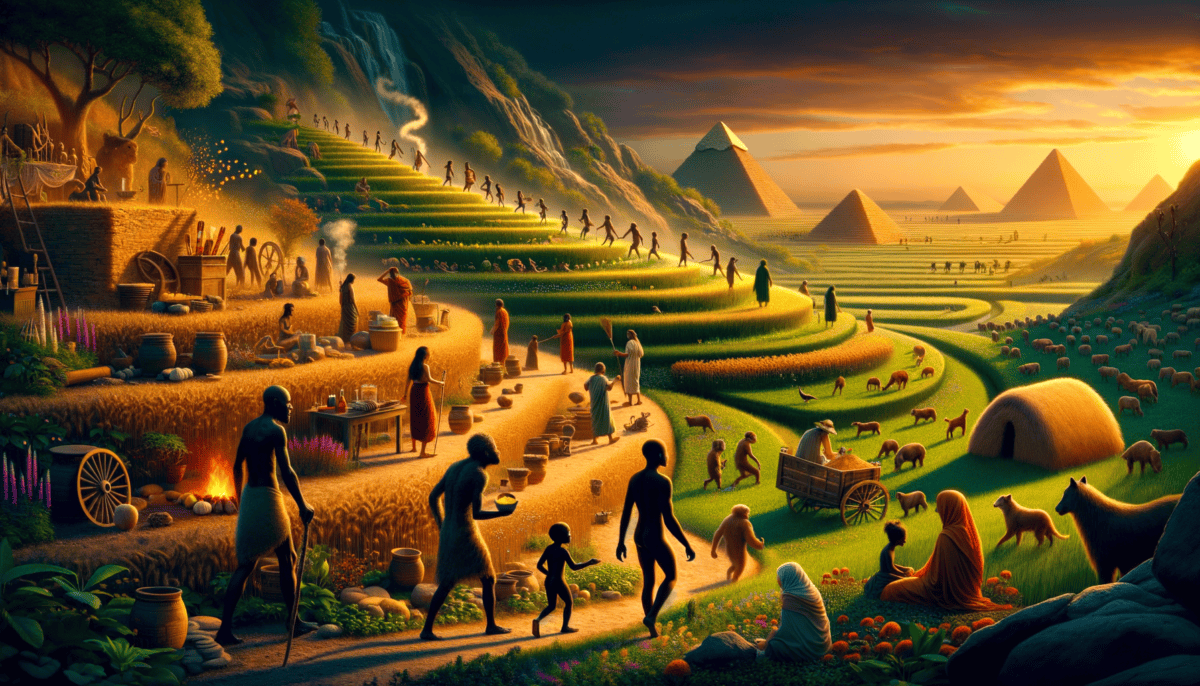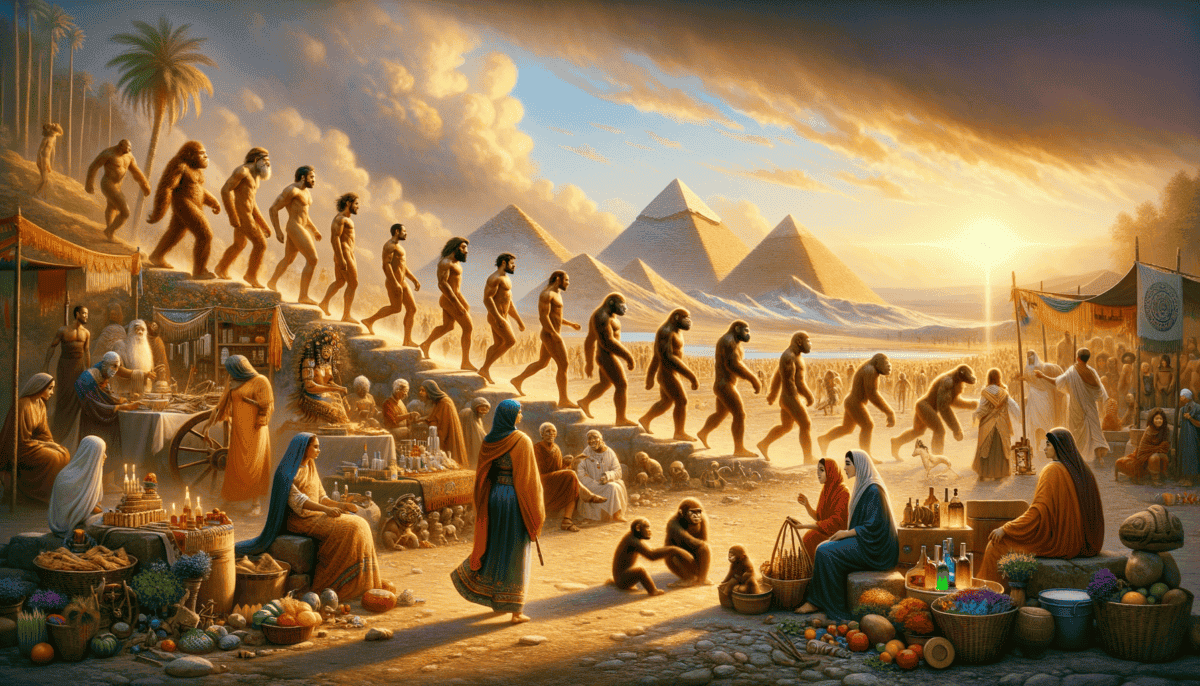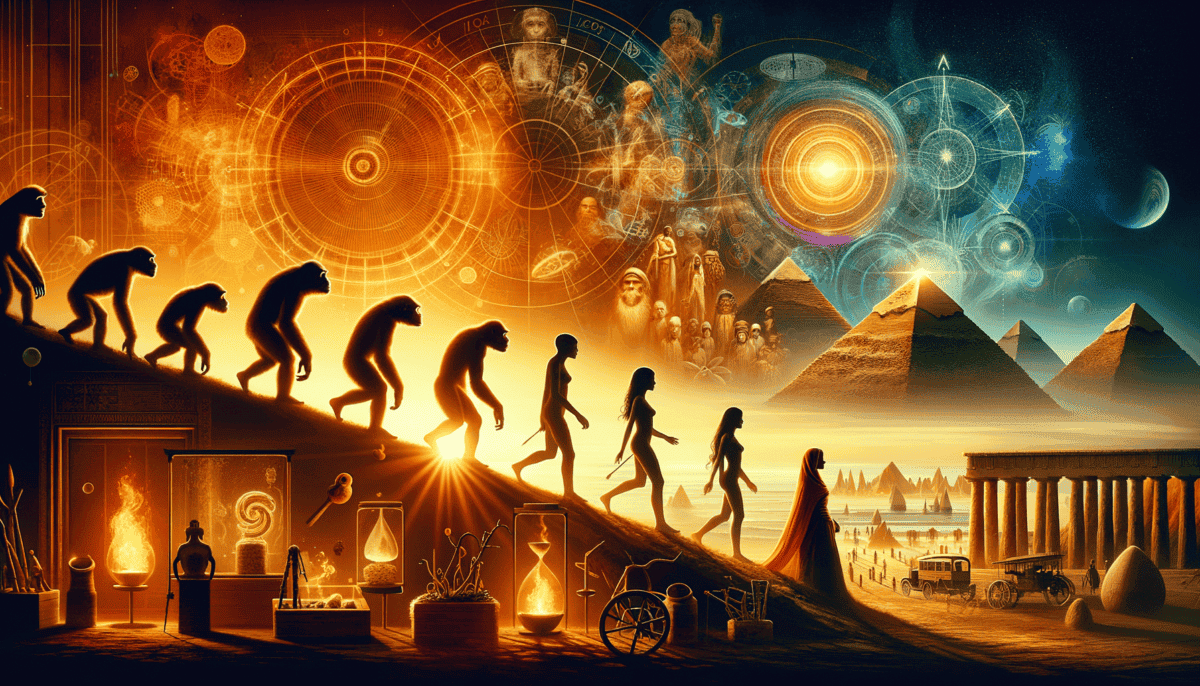The First Steps
Maya pressed her small hands against the cool glass of the museum display. Her eyes grew wide as she stared at the bones inside. These weren't just any old bones – they were the remains of someone who lived millions of years ago!
"Wow," she whispered, fog forming on the glass from her breath. "Were these really our great-great-great grandparents from super long ago?"
Dr. Sarah, Maya's favorite museum guide, smiled warmly. She had bright eyes that sparkled when she talked about human history. "In a way, yes! These bones belonged to our early human family in Africa. We call them our ancestors."
Walking Tall
"But they look different from us," Maya said, tilting her head as she studied the skeleton. It was shorter than modern humans, with longer arms and a smaller head.
"That's right! These early humans were learning to walk on two legs, just like we do now. Before that, our even earlier family members walked on all fours, like gorillas do today." Dr. Sarah demonstrated by walking normally, then playfully crawling on her hands and feet.
Maya giggled and tried walking both ways. "Walking on two legs is much better! I can see farther and carry things in my hands."
Tools of the Trade
Moving to the next display, Maya saw rough stone tools that looked like simple hammers and cutters.
"These were some of the first tools ever made," Dr. Sarah explained, pointing to the largest stone. "Our ancestors figured out how to break rocks to make sharp edges."
"Like scissors?" Maya asked excitedly.
"Sort of! But much more basic. They used these tools to cut meat and crack open bones to get to the tasty marrow inside."
Maya's face scrunched up. "Marrow? What's that?"
"It's the soft stuff inside bones. It was very good food for our ancestors – like nature's peanut butter!"
A Different World
Dr. Sarah led Maya to a large wall painting showing what Africa looked like millions of years ago. There were grasslands stretching far into the distance, scattered trees, and various animals Maya had never seen before.
"This is where our story began," Dr. Sarah said softly. "Africa was different back then. Our ancestors lived alongside all kinds of animals. They had to be clever to survive."
Maya studied the painting carefully. "Were there lions?" she asked, a bit worried.
"Yes, and many other dangerous animals! That's why living in groups was so important. They protected each other and shared food."
A Curious Mind
As they walked through the museum, Maya's questions came faster and faster. Each answer made her want to know more. She stopped at a display showing different human skulls, each one a little different from the last.
"It's like a family photo album," Maya said thoughtfully, "but super old!"
Dr. Sarah beamed at the comparison. "That's exactly right! Each skull tells us about a different member of our human family tree. And just like in your family photos, you can see how things changed over time."
Maya touched her own head gently. "Our brains got bigger," she observed, noting how the skulls changed.
"Yes! And that helped us think of new ways to survive and make better tools. It's one of the things that makes humans special – we're always learning and changing."
As the sun began to set outside the museum windows, Maya wasn't ready to leave. There was still so much to learn about where humans came from. But she knew this was just the beginning of her journey into the past. Tomorrow, she would learn about an even more exciting discovery – how humans learned to use fire!
Tools and Fire
Maya bounced excitedly as she entered the museum the next day. Her eyes sparkled with curiosity about what new secrets of human history she would discover.
The Magic of Stone Tools
“Look what I brought!” Maya pulled a smooth rock from her backpack. “Can I make tools like our ancestors did?”
Dr. Sarah smiled, taking the rock in her hands. “Our ancestors were very clever with stones. They learned to make lots of different tools.”
• Sharp cutters for meat
• Hammers for cracking nuts
• Scrapers for animal skins
• Points for digging
“But the most exciting discovery was yet to come,” Dr. Sarah said mysteriously, leading Maya to a new exhibit. “Something that changed everything!”
The First Flames
Maya gasped as she saw the display. Behind the glass, a scene showed early humans gathered around a glowing fire.
“Fire!” Maya clapped her hands. “Did they make it like we make campfires?”
“At first, they couldn’t make fire,” Dr. Sarah explained. “They had to find it in nature, like when lightning struck trees. But then they learned something amazing – they could keep it burning!”
“Like taking care of a pet?” Maya asked.
“Exactly! They fed it wood and protected it from rain. It was very special to them.”
Cooking and Warmth
Maya watched a video showing early humans cooking meat over flames. Her tummy rumbled at the thought.
“Before fire, people ate everything raw,” Dr. Sarah said. “But cooking made food softer and safer to eat. It gave them more energy to think and grow.”
“And it kept them warm!” Maya added, remembering her own cozy campfire experiences.
“Yes! Fire helped humans move to colder places where they couldn’t live before. It was like having a tiny sun they could carry with them!”
Working Together
The next display showed a group of early humans sitting around a fire, making tools together.
“Fire brought people together,” Dr. Sarah explained. “They would gather around it at night, safe from animals. This gave them time to talk and share stories.”
Maya imagined herself there, listening to tales under the stars. “Like a family dinner!”
“Fire was more than just warmth and cooking – it was the first social media! People shared news, taught their children, and created their first traditions around the flames.”
Learning to Make Fire
Dr. Sarah showed Maya a special demonstration of how early humans finally learned to make fire themselves. They used two sticks, spinning one against the other very fast.
“It took a lot of practice,” Dr. Sarah said, “but once they learned this skill, they could have fire whenever they needed it.”
Maya tried rubbing two pencils together, giggling when nothing happened. “It’s harder than it looks!”
“That’s why it was such a big discovery. It took many tries and lots of patience.”
A Brighter Future
As they walked through the rest of the exhibit, Maya saw how tools and fire changed everything for early humans. They could cook food, stay warm, scare away dangerous animals, and work together after dark.
“Tools and fire made us stronger,” Maya said thoughtfully. “But only because people shared what they learned!”
Dr. Sarah nodded proudly. “And soon, these clever humans would begin an even bigger adventure – traveling to new lands all around the world!”
Maya couldn’t wait to learn about where these brave explorers would go next. But for now, she was happy imagining those first campfires, glowing in the ancient night, bringing people together to share their stories and dreams.
Moving Across the World
Maya’s eyes widened as she looked at the giant map on the museum wall. Colorful arrows showed how people moved from Africa to places all over the world. ️
Leaving Home
“Why did people leave Africa?” Maya asked Dr. Sarah, tracing the arrows with her finger.
“Sometimes they followed animals they hunted,” Dr. Sarah explained. “Other times, they looked for new places with more food and water. Just like how birds fly south in winter!”
• Through Egypt to Asia
• Along coastlines to India
• Across ice bridges to America
• Down through islands to Australia
Facing New Challenges
Maya stopped at a display showing people in thick fur clothes. “They look so different from the African hunters!”
“That’s right! As people moved to colder places, they had to change how they lived,” Dr. Sarah said. “They made warm clothes from animal skins and found shelter in caves.”
“Each new place brought new challenges. But humans are very good at solving problems!”
Special Changes
Maya noticed something interesting about the people in different displays. “Their skin looks different in each place!”
“Yes! Over many, many years, people’s bodies changed to match where they lived,” Dr. Sarah explained. “People in sunny places kept dark skin to protect them. People in less sunny places developed lighter skin to get more vitamin D from the sun.”
Clever Solutions
“Look at all the different homes they made!” Maya pointed excitedly.
The display showed various shelters: ice houses in the Arctic, tents in grasslands, and bamboo houses in forests.
“Each group used what they could find around them,” Dr. Sarah said. “In cold places, they used snow and ice. In forests, they used wood and leaves.”
Finding Food
Maya watched a video showing different hunting methods. Some people used spears to catch fish, while others set traps for animals.
“Different places had different food,” she observed.
“That’s right! People learned what plants were safe to eat in each new place. They created special tools for catching local animals.”
Meeting New Friends
“Did different groups of people ever meet each other?” Maya asked.
“Yes! Sometimes groups would meet while traveling. They would trade things and share ideas. Some even became friends and joined together!”
Dr. Sarah showed Maya a special display of ancient jewelry made from shells that had traveled hundreds of miles through trading.
Learning from the Journey
Maya sat on a bench, thinking about all she had learned. “So my ancestors were brave explorers!”
“They sure were,” Dr. Sarah smiled. “Every person alive today comes from those brave travelers who left Africa long ago.”
“And they learned to live in so many different places,” Maya added. “Hot places, cold places, wet places, dry places!”
“That’s what makes humans special – we can adapt to live almost anywhere. And soon, these travelers would make an even bigger change in how they lived.”
Maya leaned forward eagerly. “What kind of change?”
“Well,” Dr. Sarah said with a twinkle in her eye, “instead of always moving to find food, they learned how to grow their own…”
Growing Our Own Food
Maya bounced excitedly as Dr. Sarah led her to a new exhibit showing ancient farms.
A Big Change
“Before this time, people had to chase animals and look for wild plants to eat,” Dr. Sarah explained. “But then they made an amazing discovery!”
Maya watched a video showing people planting seeds in the ground. “They learned to grow food!” she exclaimed.
• Wheat and barley
• Corn and beans
• Rice and millet
• Potatoes and squash
Making Friends with Animals
“Look at these!” Maya pointed to pictures of people with sheep and cows. “They’re not hunting them!”
“That’s right,” smiled Dr. Sarah. “People started keeping animals as pets and helpers. We call this domestication.”
“Instead of chasing animals, people gave them food and protection. The animals gave back milk, eggs, and wool.”
Building Homes
Maya moved to a display showing small villages. “These houses look different from the caves!”
“When people started growing food, they didn’t need to move around anymore,” Dr. Sarah explained. “They built permanent homes near their farms.”
“They made houses from mud bricks, wood, and stone. Some even had special rooms for storing food!”
Working Together
The next display showed many people working in fields together.
“Farming was hard work,” said Dr. Sarah. “People had to help each other. Some planted seeds, others took care of animals, and some built houses.”
“Like a big team!” Maya said.
New Jobs
“Did everyone work on farms?” Maya asked.
“Not everyone! Some people became pottery makers.” Dr. Sarah showed Maya beautiful clay pots. “Others became builders, traders, or leaders.”
“For the first time, people could choose different jobs!”
Living in Towns
Maya stared at a model of an ancient town. It had many houses close together, with paths between them.
“As more people lived together, they made rules to help everyone get along,” Dr. Sarah said. “They created markets to trade things and temples to pray together.”
Growing Knowledge
“Look what they invented!” Maya pointed to pictures of wheels, plows, and irrigation channels.
“Yes! People had more time to think and create new tools,” Dr. Sarah explained. “They learned about seasons and weather to help their crops grow better.”
Sharing Stories
“What’s this?” Maya asked, pointing to strange marks on clay tablets.
“That’s writing! People started making marks to count their crops. Later, they used these marks to tell stories and share ideas.” ✍️
Maya touched the glass case gently. “So farming changed everything?”
“It sure did! It changed how people lived, worked, and thought,” Dr. Sarah replied. “And these changes led to something even more amazing – the birth of different cultures around the world.”
Maya’s eyes sparkled with curiosity. “Different cultures? Tell me more!”
Sharing Our Stories
Maya and Dr. Sarah stepped into a colorful room filled with displays from around the world.
Many Ways to Live
“Wow!” Maya spun around, looking at the different clothes, tools, and houses. “Everyone lives so differently!”
“Yes,” Dr. Sarah smiled. “As people spread across the world, they created unique ways of living. We call these different ways cultures.”
• The food they eat
• The clothes they wear
• The stories they tell
• The way they celebrate
• The houses they build
Sharing Food
Maya stopped at a display showing different meals. “Look at all this yummy food!”
“Each group of people learned to cook with what grew near them,” Dr. Sarah explained. “Some ate rice, others corn, and some ate lots of fish.”
“When people met other groups, they shared their food and recipes. That’s why we can eat pizza from Italy and tacos from Mexico today!”
Speaking Together
“Listen to this!” Maya put on headphones playing different languages.
“People made up different words to talk to each other,” said Dr. Sarah. “Some write their words like we do, others use pictures, and some use different shapes.” ✍️
Making Music
Maya picked up a drum carefully. “Can I try it?”
“Go ahead! Music is part of every culture,” Dr. Sarah said. “Some people use drums, others use strings, and some just use their voices.”
“Every culture has special songs for happy times and sad times.”
Working Together
The next display showed people trading goods at a market.
“Even though people lived differently, they learned to work together,” Dr. Sarah explained. “They traded things they made and shared new ideas.”
“Like a big world family!” Maya said.
Special Celebrations
Maya watched a video of different festivals. “Everyone looks so happy!”
“Each culture has special days to celebrate,” said Dr. Sarah. “Some celebrate when crops grow, others when babies are born, and some when the seasons change.”
Learning From Each Other
“When cultures meet, amazing things happen,” Dr. Sarah said. “They share stories, learn new ways to make things, and create new ideas together.”
“And that’s how we got smartphones?” Maya asked.
“Exactly! People from many cultures worked together to make them.”
Growing Together
“Today, we can talk to people all over the world,” Dr. Sarah explained. “We can learn about different cultures and share our own stories.”
Maya looked thoughtful. “So even though we’re different, we’re all connected?”
“That’s right! And that connection helps us solve big problems and make new discoveries.”
Maya watched children from different cultures playing together on a screen. “What happens next, Dr. Sarah? How do all these cultures help us today?”
Building Tomorrow Together
Maya sat cross-legged on the museum floor, looking up at a giant screen showing people from all over the world.
A Special Discovery
“Maya,” Dr. Sarah said softly, “you’ve learned so much about where we came from. What do you think happens next?”
Maya’s eyes sparkled. “We keep growing and learning together!”
• How we learned to walk on two legs
• How we made tools and used fire
• How we moved around the world
• How we grew food and built homes
• How we share different cultures
Today’s World
“Look at this!” Maya pointed to a display showing modern cities. ️
“We’ve built amazing things,” Dr. Sarah agreed. “We have tall buildings that touch the sky, fast trains that zoom between cities, and tiny computers in our pockets.”
“But the most amazing thing is how we work together to solve big problems!”
Helping Our Earth
Maya watched a video of people planting trees.
“Just like our early ancestors took care of their home, we’re learning to take better care of our Earth,” Dr. Sarah explained.
“I want to help too!” Maya said excitedly.
New Ways to Talk
The next display showed people video chatting across continents.
“Remember how early humans made the first words?” Dr. Sarah asked. “Now we can talk to anyone, anywhere, anytime!”
“Like when I call Grandma in another country!” Maya smiled.
Learning Never Stops
“We’re still discovering new things every day,” Dr. Sarah said. “Scientists are exploring space, finding cures for sickness, and inventing new ways to live better.”
“Will we ever stop learning?” Maya asked.
“Never! That’s what makes humans special – we always want to learn more.”
Everyone’s Story
Maya stood up and walked to a mirror wall. She saw herself surrounded by images of people from different times and places.
“You know what’s really cool?” she said. “We’re all part of the same big story!”
“That’s exactly right,” Dr. Sarah beamed. “From the first humans in Africa to you standing here today – we’re all connected.”
Your Turn
As they walked toward the museum exit, Maya stopped. “Dr. Sarah, what happens next in our story?”
“That’s the most exciting part,” Dr. Sarah smiled. “You get to help write it! Every person adds their own chapter to humanity’s big story.” ✨
Maya skipped down the steps into the bright sunshine. She couldn’t wait to tell her friends about everything she learned. More importantly, she couldn’t wait to see what amazing things people would do next.
“Maybe someday,” she thought, “someone will learn about the great things my generation did to make the world better!”
As Maya waved goodbye to Dr. Sarah, she knew this wasn’t the end of the story – it was just the beginning of her own chapter in the amazing journey of human history.






